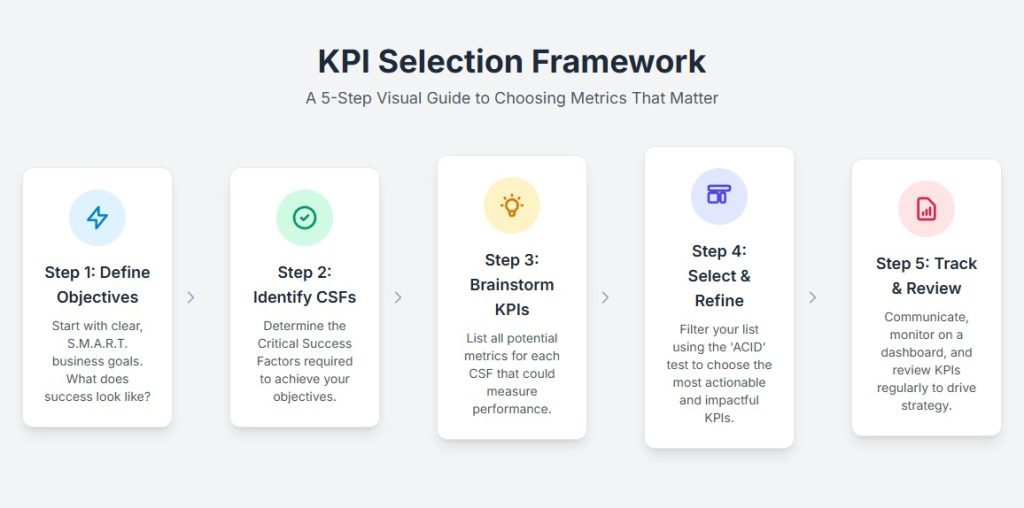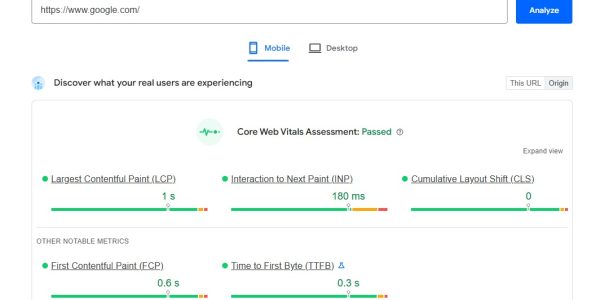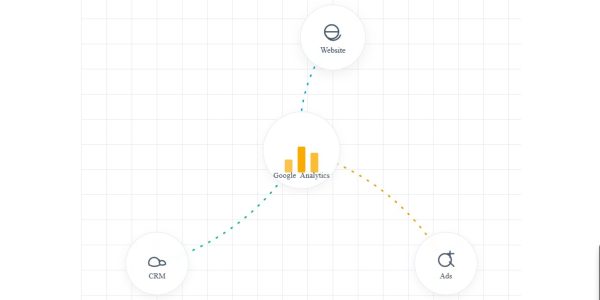You’ve been there. Staring at a dashboard flooded with charts and numbers. Website traffic is up, social media likes are pouring in, and your email open rates are hitting new highs. On the surface, everything looks great. But when you look at the bottom line, nothing has changed. Revenue is flat, qualified leads are scarce, and you have this nagging feeling you’re celebrating the wrong victories.
This is the classic tale of being data-rich but insight-poor. You’re tracking metrics, but are they the right metrics? Are they Key Performance Indicators?
The challenge of choosing the right Key Performance Indicators is one of the most critical hurdles for any business aiming for sustainable growth. It’s the difference between busy work and effective work, between spending your budget and investing it. This guide will provide a clear, actionable framework to help you select KPIs that provide true strategic clarity and drive meaningful results.

What Are KPIs, Really? (And What They Are Not)
Before we dive into the “how,” let’s clarify the “what.”
A Key Performance Indicator (KPI) is a measurable value that demonstrates how effectively a company is achieving its key business objectives. In simpler terms, KPIs are the critical signposts on your road to success. They tell you if you’re on the right path or if you need to make a U-turn.
It’s crucial to differentiate KPIs from standard business metrics.
- Metrics measure a business process (e.g., website visitors, email open rate, number of social media followers).
- KPIs are a specific subset of metrics that are directly tied to a strategic goal. They measure performance and progress towards what’s most important.
All KPIs are metrics, but not all metrics are KPIs. The number of Instagram followers you have is a metric. The number of qualified leads generated from Instagram that convert into customers is a KPI, assuming your objective is customer acquisition. This distinction is the first step in choosing the right Key Performance Indicators that matter.
Why Choosing the Right KPIs is Crucial for Success
Selecting the right KPIs isn’t just an analytical exercise; it’s a foundational business strategy. When done correctly, it provides:
- Focus and Alignment: KPIs unite your team around common goals. Everyone knows what the “win” looks like and how their work contributes to it.
- Data-Driven Decision Making: Instead of relying on gut feelings, you can make strategic adjustments based on real performance data. Should you invest more in SEO or PPC? Your KPIs will hold the answer.
- Accountability and Performance Management: Clear KPIs make it easy to track progress and hold teams and individuals accountable for their results.
- Early Warning System: Lagging KPIs can alert you to problems before they become crises, giving you time to course-correct.
The 5-Step Framework for Choosing the Right Key Performance Indicators
Feeling overwhelmed? Don’t be. This simple, five-step framework will guide you through the process of identifying and selecting the most impactful KPIs for your business.
Step 1: Define Your Business Objectives
You cannot measure progress if you haven’t defined the destination. Before you even think about a single metric, you must have clearly defined, written-down business objectives. The best objectives follow the S.M.A.R.T. criteria:
- Specific: What exactly do you want to achieve?
- Measurable: How will you quantify the result?
- Achievable: Is this goal realistic with your available resources?
- Relevant: Does this objective align with your overall business vision?
- Time-bound: When do you want to achieve this goal?
Example of a weak objective: “Increase sales.” Example of a S.M.A.R.T. objective: “Increase online sales from our e-commerce store by 20% in the next fiscal quarter (Q4).”
Step 2: Identify Critical Success Factors (CSFs)
Once you have your objective, ask yourself: “What activities must go right for us to achieve this goal?” These are your Critical Success Factors.
For our objective of “Increase online sales by 20% in Q4,” the CSFs might be:
- Increase qualified traffic to product pages.
- Improve the website’s checkout conversion rate.
- Increase the Average Order Value (AOV).
- Encourage repeat purchases from existing customers.
Step 3: Brainstorm Potential KPIs for Each Factor
Now, for each CSF, brainstorm specific metrics you can use to track performance. This is where you connect your actions to your goals. Don’t filter yourself yet; just list out everything you could possibly measure.

For the CSF “Increase qualified traffic to product pages”:
- Organic search traffic
- Paid search traffic
- Click-Through Rate (CTR) from ads
- Keyword rankings for high-intent terms
For the CSF “Improve the website’s checkout conversion rate”:
- Overall E-commerce Conversion Rate
- Cart abandonment rate
- Checkout completion rate
For the CSF “Increase the Average Order Value (AOV)”:
- Average Order Value ($)
- Number of items per order
- Upsell/cross-sell attachment rate
Step 4: Select and Refine Your KPIs (The “ACID” Test)
Your brainstorm list is likely long. You can’t track everything. The art of choosing the right Key Performance Indicators lies in selecting the few that have the most impact. Run your potential KPIs through the “ACID” test:
- A – Actionable: Does this metric give you clear insight that you can act upon? “Website traffic” isn’t very actionable. “Organic traffic to high-converting product pages,” however, tells you that your SEO efforts for those pages are working.
- C – Clear: Is the KPI easy to understand and communicate? If you need a Ph.D. in statistics to explain it, it’s not a good KPI.
- I – Impactful: Is this KPI directly tied to your S.M.A.R.T. objective? Will moving this number significantly affect your goal?
- D – Drivable: Can your team directly influence this metric with their actions? If the KPI is largely outside of your control, it creates frustration, not motivation.
Using the ACID test, you can filter your long list down to a handful of true KPIs. For our example, you might select E-commerce Conversion Rate, Average Order Value (AOV), and Customer Lifetime Value (CLV) as your primary sales KPIs.
Step 5: Communicate, Track, and Review
KPIs are useless if they’re hidden in a spreadsheet.
- Communicate: Share the chosen KPIs with your entire team. Everyone should understand what they are, why they were chosen, and how their work affects them.
- Track: Use a dashboard to monitor your KPIs in real-time or on a regular schedule (daily, weekly, monthly).
- Review: Set a regular cadence to review your KPIs. Are you on track? If not, why? What needs to change? Remember, KPIs are not set in stone. As your business objectives evolve, your KPIs should too.
Common KPI Categories for Digital Marketing
To give you a head start, here are some common and effective KPIs broken down by digital marketing channel. Remember to always tie these back to your specific business objectives.
For Website & SEO Performance
- Customer Acquisition Cost (CAC): The total cost to acquire a new customer.
- Conversion Rate: The percentage of visitors who complete a desired action (e.g., make a purchase, fill out a form).
- Organic Traffic & Leads/Sales: The number of visitors and conversions coming from search engines.
- Keyword Rankings for High-Intent Terms: Your position in search results for keywords that signal a user is ready to buy.
For Paid Advertising (PPC)
- Return on Ad Spend (ROAS): The amount of revenue generated for every dollar spent on advertising. The ultimate PPC KPI.
- Cost Per Acquisition (CPA): The cost to acquire a single lead or customer through a specific campaign.
- Click-Through Rate (CTR): A measure of ad relevance and creative effectiveness.
- Quality Score / Relevance Score: A platform-specific score (e.g., Google Ads, Facebook Ads) that impacts your ad costs and placement.
For Content Marketing
- Lead Magnet Downloads: How many people are downloading your gated content (e-books, whitepapers).
- Content-Influenced Revenue: Using analytics to track how many customers interacted with a piece of content before converting.
- Time on Page / Engagement Rate: An indicator of how engaging and valuable your content is to readers. [Internal link: Read our guide on creating engaging content].
How Infineural Technologies Simplifies KPI Tracking
You’ve done the hard strategic work of choosing the right Key Performance Indicators. Now comes the operational challenge: how do you track them efficiently without spending half your week buried in different analytics platforms and spreadsheets?
This is where data fragmentation becomes a major bottleneck. Your SEO data is in Google Search Console, your ad data is in Google Ads and LinkedIn, your website data is in Google Analytics, and your sales data is in your CRM. Manually pulling this information together is tedious, time-consuming, and prone to error.
At Infineural Technologies, we solve this exact problem. Our intelligent analytics platform integrates seamlessly with all your essential marketing and sales tools. Instead of logging into a dozen different platforms, you get a single, unified dashboard that visualizes your most important KPIs in real time.
With Infineural Technologies, you can:
- Automate Reporting: Stop wasting hours on manual report building. Get beautiful, insightful reports delivered to your inbox automatically.
- Gain Deeper Insights: Our platform doesn’t just show you data; it helps you understand the story behind it, connecting marketing activities directly to revenue outcomes.
- Focus on Strategy, Not Spreadsheets: By simplifying data collection and visualization, we empower your team to focus on what they do best: creating strategies that move the needle on your KPIs.
Think of it as the command center for your growth engine, giving you the clarity needed to make faster, smarter decisions.
Conclusion: From Data Overload to Strategic Clarity
Choosing the right Key Performance Indicators is a journey from chaos to clarity. It’s about consciously deciding to measure what matters, not just what’s easy to count. By starting with your core business objectives and following a structured framework, you can transform data from a source of confusion into your most powerful strategic asset.
Stop chasing vanity metrics. Define your goals, select KPIs that directly impact those goals, and empower your team with the tools to track and act on them. This is the path to predictable, sustainable growth.
Ready to get a crystal-clear view of your most important KPIs?
Stop guessing and start growing. Talk to an expert at Infineural Technologies today and see how our unified analytics platform can help you measure what truly matters. [Schedule Your Free Demo Now]


